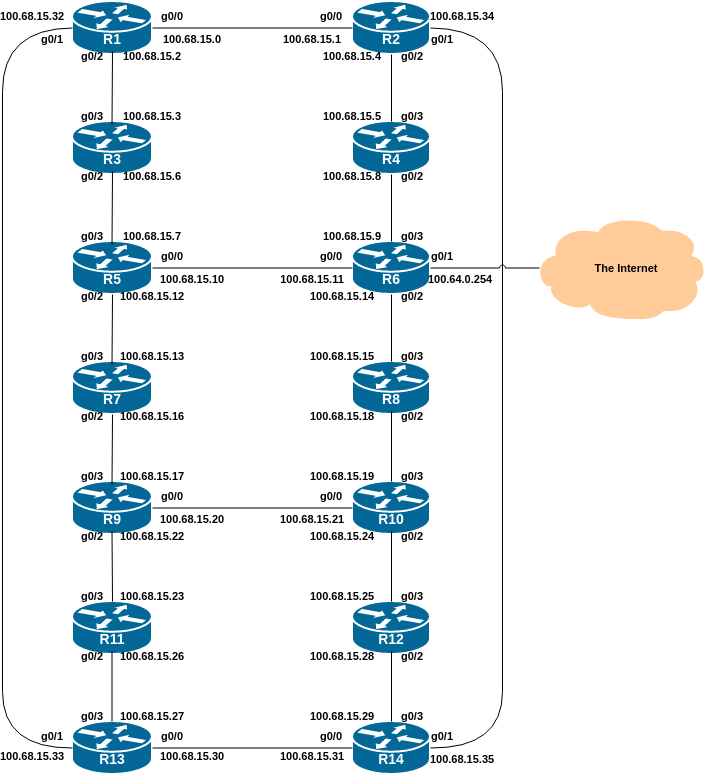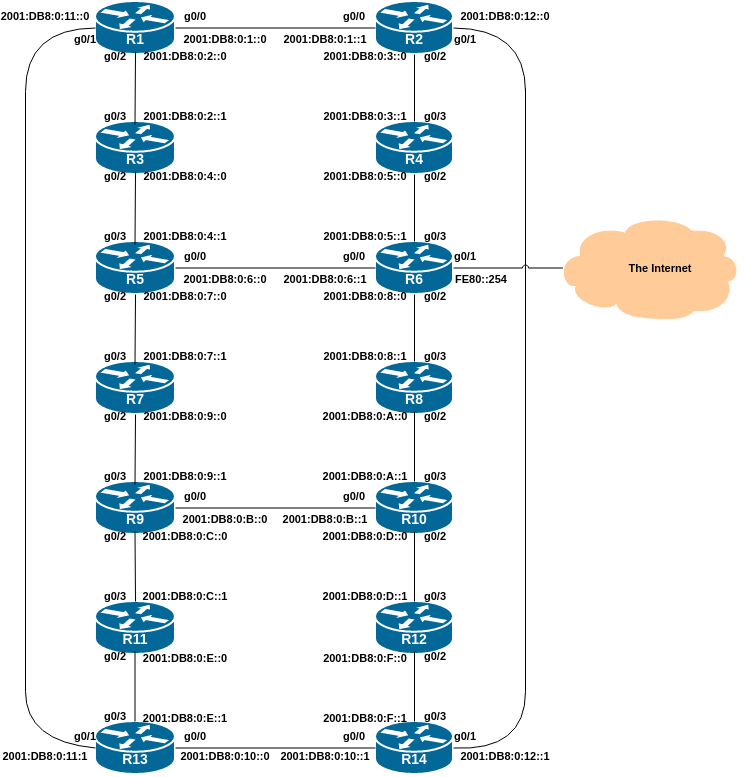
This document describes the IP address plan we will use for the workshop exercises which have a flat topology using a single autonomous system. Note the following tables carefully, making sure you are using the correct resources for your router and your AS.
The IPv4 address space used in these exercises is from subnets of 100.64.0.0/10 which is an IPv4 Shared Address block. It must not be routed on the Internet.
Note that 2001:DB8::/32 is the IPv6 Documentation Address block. It must not be routed on the Internet.
And finally note that the 2001:10::/28 address block has been listed in the IANA special registry for future use. It must not be routed on the Internet.
If using these labs as inspiration for your own infrastructure design, please replace all instances of private, documentation, and unassigned address space with your own address blocks.
The initial lab is a simple flat network comprising of 14 routers. This initial lab will take address space out of 100.68.0.0/20 for IPv4 and 2001:DB8::/32 for IPv6.
For IPv4, the links between the routers and the router Loopback interfaces will be numbered out of 100.68.15.0/24, the last /24 in the /20 we have set aside for the lab.
For IPv6, the links between the routers and the router Loopback interfaces will be numbered out of 2001:DB8:0::/48, with the Loopbacks being numbered out of 2001:DB8:0:FFFF::/64 (the last /64 in that /48 block).
Each router will also originate a subnet when BGP is set up. The table below shows the Loopbacks and the subnets which are originated:
| Router | IPv4 Loopback | IPv6 Loopback | Customer IPv4 subnet | Customer IPv6 subnet |
|---|---|---|---|---|
| R1 | 100.68.15.241 | 2001:DB8:0:FFFF::1 | 100.68.0.0/26 | 2001:DB8:1::/48 |
| R2 | 100.68.15.242 | 2001:DB8:0:FFFF::2 | 100.68.0.64/26 | 2001:DB8:2::/48 |
| R3 | 100.68.15.243 | 2001:DB8:0:FFFF::3 | 100.68.0.128/26 | 2001:DB8:3::/48 |
| R4 | 100.68.15.244 | 2001:DB8:0:FFFF::4 | 100.68.0.192/26 | 2001:DB8:4::/48 |
| R5 | 100.68.15.245 | 2001:DB8:0:FFFF::5 | 100.68.1.0/26 | 2001:DB8:5::/48 |
| R6 | 100.68.15.246 | 2001:DB8:0:FFFF::6 | 100.68.1.64/26 | 2001:DB8:6::/48 |
| R7 | 100.68.15.247 | 2001:DB8:0:FFFF::7 | 100.68.1.128/26 | 2001:DB8:7::/48 |
| R8 | 100.68.15.248 | 2001:DB8:0:FFFF::8 | 100.68.1.192/26 | 2001:DB8:8::/48 |
| R9 | 100.68.15.249 | 2001:DB8:0:FFFF::9 | 100.68.2.0/26 | 2001:DB8:9::/48 |
| R10 | 100.68.15.250 | 2001:DB8:0:FFFF::A | 100.68.2.64/26 | 2001:DB8:A::/48 |
| R11 | 100.68.15.251 | 2001:DB8:0:FFFF::B | 100.68.2.128/26 | 2001:DB8:B::/48 |
| R12 | 100.68.15.252 | 2001:DB8:0:FFFF::C | 100.68.2.192/26 | 2001:DB8:C::/48 |
| R13 | 100.68.15.253 | 2001:DB8:0:FFFF::D | 100.68.3.0/26 | 2001:DB8:D::/48 |
| R14 | 100.68.15.254 | 2001:DB8:0:FFFF::E | 100.68.3.64/26 | 2001:DB8:E::/48 |
Point-to-point links used in operational networks today are addressed as follows (as was covered in the presentations):
IPv4 - a /31 is used for the point-to-point link address (although several network operators are using unnumbered interfaces)
IPv6 - a whole /64 is reserved for the point-to-point link, but the actual assignment itself is a /127 for the link address (and again unnumbered/link-local addressing can be used instead)
The following diagram shows the IPv4 addressing of the point-to-point links as implemented in the lab topology. Each IPv4 point-to-point link is a /31 subnet.

The following diagram shows the IPv6 addressing of the point-to-point links as implemented in the lab topology. Each IPv6 point-to-point link is a /127 subnet out of a /64.
